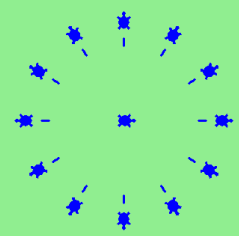1.
Write a program that prints
We like Python's turtles! 100 times.Solution.
for i in range(100):
print("We like Python's turtles!")
We like Python's turtles! 100 times.for i in range(100):
print("We like Python's turtles!")
One of the months of the year is JanuaryOne of the months of the year is FebruaryOne of the months of the year is Marchfor amonth in ['January', 'February', 'March', 'April', 'May', 'June', 'July', 'August', 'September', 'November', 'December']:
print("One of the months of the year is", amonth)
12, 10, 32, 3, 66, 17, 42, 99, 20
for loops to make a turtle draw these regular polygons (regular means all sides the same lengths, all angles the same):# draw an equilateral triangle
import turtle
wn = turtle.Screen()
norvig = turtle.Turtle()
for i in range(3):
norvig.forward(100)
# the angle of each vertice of a regular polygon
# is 360 divided by the number of sides
norvig.left(360/3)
wn.exitonclick()
# draw a square
import turtle
wn = turtle.Screen()
kurzweil = turtle.Turtle()
for i in range(4):
kurzweil.forward(100)
kurzweil.left(360/4)
wn.exitonclick()
# draw a hexagon
import turtle
wn = turtle.Screen()
dijkstra = turtle.Turtle()
for i in range(6):
dijkstra.forward(100)
dijkstra.left(360/6)
wn.exitonclick()
# draw an octogon
import turtle
wn = turtle.Screen()
knuth = turtle.Turtle()
for i in range(8):
knuth.forward(75)
knuth.left(360/8)
wn.exitonclick()
160, -43, 270, -97, -43, 200, -940, 17, -86. (Positive angles are counter-clockwise.) Use a turtle to draw the path taken by our drunk friend. After the pirate is done walking, print the current heading.import turtle
wn = turtle.Screen()
lovelace = turtle.Turtle()
# move the turtle forward a little so that the whole path fits on the screen
lovelace.penup()
lovelace.forward(60)
# now draw the drunk pirate's path
lovelace.pendown()
for angle in [160, -43, 270, -97, -43, 200, -940, 17, -86]:
# we use .left() so that positive angles are counter-clockwise
# and negative angles are clockwise
lovelace.left(angle)
lovelace.forward(100)
# the .heading() method gives us the turtle's current heading in degrees
print("The pirate's final heading was", lovelace.heading())
wn.exitonclick()
run and check your answer.
import turtle
turing = turtle.Turtle()
for i in range(5):
turing.forward(110)
turing.left(216)

import turtle
tanenbaum = turtle.Turtle()
tanenbaum.hideturtle()
tanenbaum.speed(20)
for i in range(350):
tanenbaum.forward(i)
tanenbaum.right(98)
import turtle
wn = turtle.Screen()
babbage = turtle.Turtle()
babbage.shape("triangle")
n = int(input("How many legs should this sprite have? "))
angle = 360 / n
for i in range(n):
# draw the leg
babbage.right(angle)
babbage.forward(65)
babbage.stamp()
# go back to the middle and turn back around
babbage.right(180)
babbage.forward(65)
babbage.right(180)
babbage.shape("circle")
wn.exitonclick()